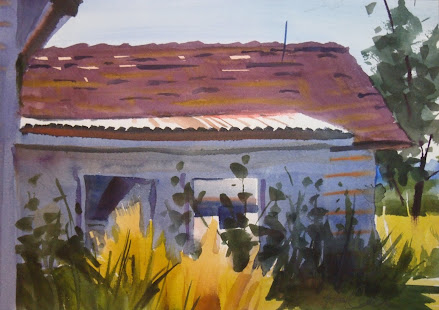Thursday, November 12, 2020
Intermediate Watercolor Homework, 11/12/20, Too Fast to be Fussy
Beginning Watercolor Homework, 11/12/20, Which Edges Should be Soft and Which Hard?
The images below display a mix of hard and soft edges. This exercise will produce a device that helps you decide where you want the specificity that hard edges provide and where you prefer the generality of soft edges. The concept is simple; paint a version of one of the selected images using only soft edges.
When the painting is dry you can look for places where you really want hard edges. Be conservative, choosing the places that you feel most require hard edges. Paint the hard-edged shapes right over the initial soft ones. stop after each hard edge and stand back a little, to get some distance on the big picture. Just because a shape has hard edges in the photo doesn't mean the painting needs them, too.
You may have to wet both sides of your paper to get it to stay wet longer.
Thursday, November 5, 2020
Intermediate Watercolor Homework, 11/5/20 Trees, Green and Otherwise
Before all the leaves are gone let's shine the spotlight on trees for a while. If you have a tree view by all means paint from life. Working from photos is also fine, as well as copying other painters. Here's a bunch of images to get you started
Beginning Homework 11/5/20 While the Paper is Still Wet...
Large sections of these two landscapes were painted just after the initial wash was applied , while the paper was still wet.
Zooming in on the one with the fence, we can see some of what was done while the paper was still wet. The blue hill has a hard edge where it meets the sky, and a soft edge where it meets the yellow.
Look at the edges of the clouds; some are hard and some are soft.
In both paintings there is a casual feeling regarding edges. In the one directly above you can tell that it wasn't essential for the trees to all be hard-edged or soft. A mix of edges was considered acceptable.
In the backyard painting, above, it seemed important to keep most of the edges hard. Since light and shadow is the main subject, there should be no uncertainty about whether any given shape is sunlit . Keeping the shapes separated with hard edges helps support the illusion of strong light.
Choose one of the photos below and take your time deciding which edges you want to keep hard and which soft. Plan how you'll bring this about.
Remember you can keep the paper wet longer by using lots of water in the initial wash, and you can keep your shapes from feathering too much by using thick paint for the secondary wet into wet strokes.

















